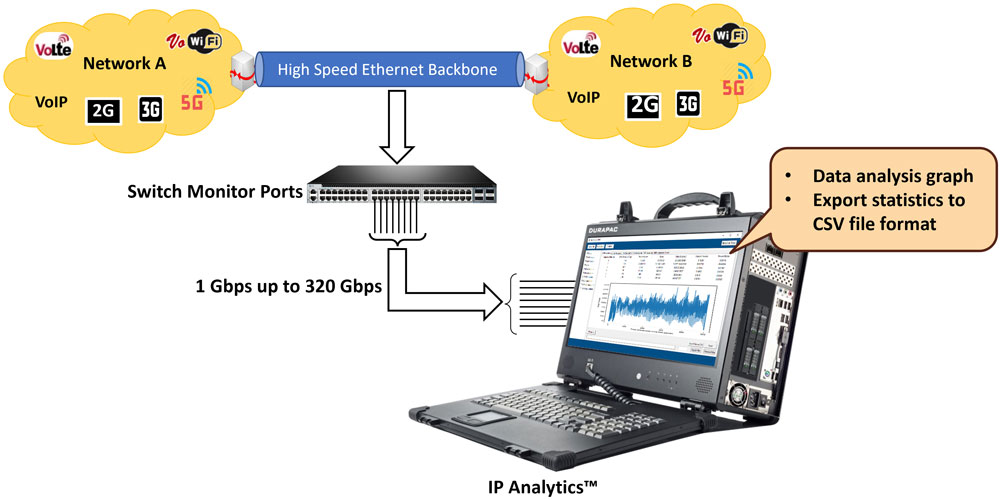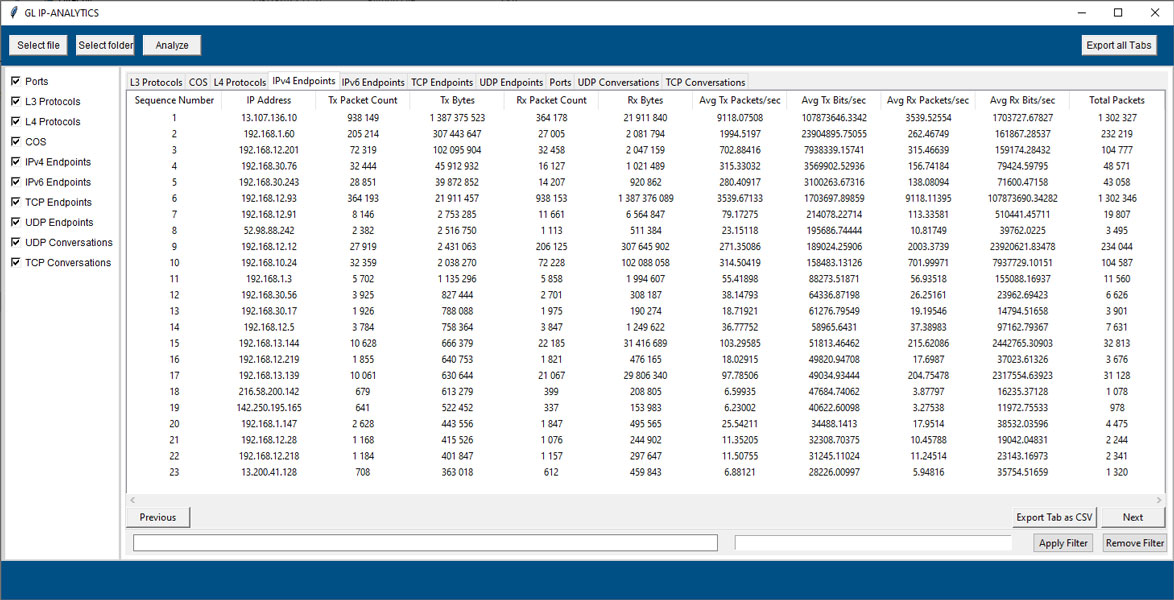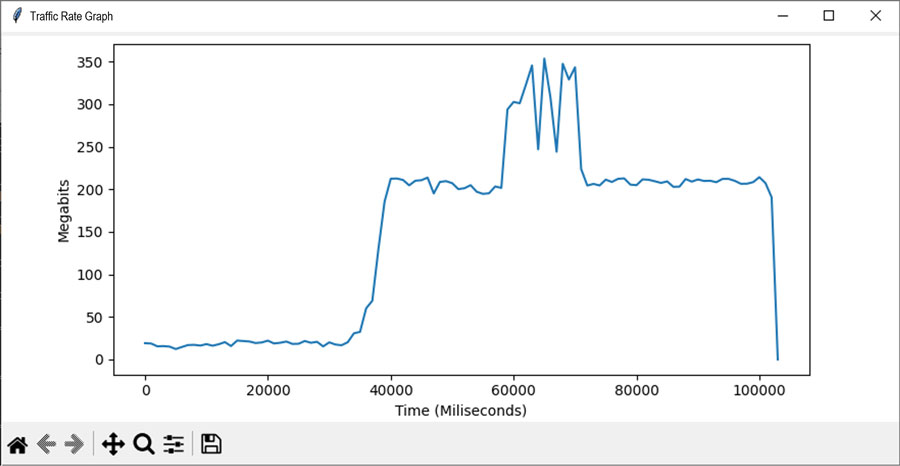Introducing GL's IP Analytics™ Tool: Transforming Network Analysis
Welcome to GL's latest newsletter, where we discuss our new “IP Analytics™ Tool” application designed for analyzing data in IP (Internet Protocol) networks. This tool is essential for monitoring and maintaining Quality of Service (QoS) in telecom networks by examining IP-based data streams.

Overview
GL announces the launch of the latest feature set - IP Analytics™, a powerful addition to GL’s suite of network analysis tools. IP Analytics™ provides detailed insight into recorded IP traffic captured at high speed. By analyzing IP traffic and data, telecom companies can enhance network performance, troubleshoot malfunctioning infrastructure, improve customer satisfaction, and increase operational efficiency. Let us dive into what makes IP Analytics™ an indispensable tool for service providers and network administrators.
Comprehensive Packet Capture and Flow Grouping
At the core of IP Analytics™ is its ability to capture all Ethernet packets, meticulously grouping them into flows based on key parameters:
- IP Class Of Service
- IP Address (both Source and Destination)
- UDP/TCP Port Numbers (both source and destination)
In-Depth Traffic Categorization
IP Analytics™ enables you to categorize packets and flows with precision, offering several perspectives:
- Flow Based on IP Class Of Service: Understand how different classes of service impact your network's performance
- Flow Based on Unique IP Address: View the amount of traffic transmitted and received by individual IP nodes, offering insights into network load and potential bottlenecks
- Flow Based on IP Conversation: Analyze the traffic between pairs of IP nodes, enhancing your understanding of network interactions
- Flow Based on Applications: Identify application-specific traffic patterns based on TCP/UDP port numbers, crucial for application performance monitoring
Advanced Metrics and Visualization
What sets IP Analytics™ apart is its ability to compute and visualize key network metrics with millisecond precision:
- Packet Count and Byte Count for Each Flow: Measure the volume of data within each categorized flow
- Packets/sec and Bits/sec: Dynamically calculate and plot these rates, offering real-time insights into network throughput
These metrics are not only calculated for each flow but also for each Ethernet port, providing a comprehensive overview of network performance.
Data Analytics with VAEX and Custom Filtering
Leveraging the export capabilities from IP Analyzer, which is then converted into HDF5 format, IP Analytics™ allows you to perform extensive data analytics operations using VAEX (Python Library). This integration ensures that you can easily handle large datasets, applying various analytics operations with efficiency and speed.
Additionally, IP Analytics™ introduces a powerful customized filtering mechanism. This feature empowers users to conduct detailed analysis on specific portions of the traffic, enabling targeted troubleshooting and performance optimization.
Empower Your Network Analysis with IP Analytics™
IP Analytics™ transforms how users view and manage network traffic. Whether users are looking to monitor application performance, optimize network flow, or simply gain deeper insights into the network's data patterns, IP Analytics™ provides the tools and precision you need.
Using PacketScan™ HD system along with FastRecorder™ application, users can capture the traffic and analyze the captured data using GL IP Analytics™ tool. This device comes in rack-mountable and portable form factors and supports data rates from 1 Gbps to 100 Gbps. Therefore, it is an all-in-one solution for both high speed capture and real-time analysis.
GL's IP Analytics™ tool is designed to analyze HDF5 files, extracting comprehensive statistics. From Layer 3 Protocols to Class of Service (Differentials Services Codepoint), Layer 4 Protocols, and beyond, it provides insights into IPv4 Endpoints, IPv6 Endpoints, UDP Endpoints, TCP Endpoints, UDP Conversation, TCP Conversation, and Port wise details. It is an easy-to-use solution for in-depth data exploration.

With PacketExtractor™, an optional add-on to PacketScan™ HD, users can now conduct Rate Analysis effortlessly. We have integrated GL's Traffic Rate Graph Plotter tool for enhanced functionality. GL's Traffic Rate Graph analyzes HDF5 files and generates graphs for individual recorded ports.
The below graph indicates a consistent rate of 20 Mbps bandwidth. However, at the 40th second, there is a sudden increase to 200 Mbps bandwidth. Additionally, there are spikes in the rate between 60 and 75 seconds. These rates analysis helps network provider in troubleshooting bandwidth requirement by examining the graph at various time intervals with millisecond precision.

Key features:
- Comprehensive Coverage: Includes detailed analysis of different IP layers such as Layer 3 Protocols, Class of Services (DSCP), Layer 4 Protocols, IPv4 Endpoints, IPv6 Endpoints, TCP Endpoints, UDP Endpoints, Recorded Port statistics, UDP Conversations and TCP Conversations along with Port wise details
- Input Output Graph Support: Provides in-depth graph analysis for both Bits/sec and Packets/sec
- Advanced Filtering: Provides advanced filters to analyze the required packets
- Export Functionality: Easily export information from all tabs or specific tab information to CSV file format for further analysis
- Flexible File Selection: Allows selection of either a single Data Analysis HDF5 file or multiple HDF5 files from the folder
- Column Sorting Options: Provides the flexibility to sort columns in Ascending or Descending order for easier data interpretation
- Traffic Rate Graphs: Plots rate analysis graphs for various time intervals
 Back to Newsletter Index Page
Back to Newsletter Index Page